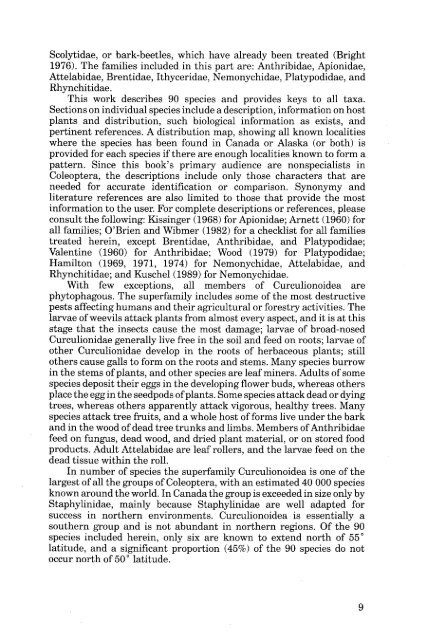Weevils - Entomological Society of Canada
Weevils - Entomological Society of Canada
Weevils - Entomological Society of Canada
Create successful ePaper yourself
Turn your PDF publications into a flip-book with our unique Google optimized e-Paper software.
Scolytidae, or bark-beetles, which have already been treated (Bright<br />
1976). The families included in this part are: Anthribidae, Apionidae,<br />
Attelabidae, Brentidae, Ithyceridae, Nemonychidae, Platypodidae, and<br />
Rhynchitidae.<br />
This work describes 90 species and provides keys to all taxa.<br />
Sections on individual species include a description, information on host<br />
plants and distribution, such biological information as exists, and<br />
pertinent references. A distribution map, showing all known localities<br />
where the species has been found in <strong>Canada</strong> or Alaska (or both) is<br />
provided for each species ifthere are enough localities known to form a<br />
pattern. Since this book's primary audience are nonspecialists in<br />
Coleoptera, the descriptions include only those characters that are<br />
needed for accurate identification or comparison. Synonymy and<br />
literature references are also limited to those that provide the most<br />
information to the user. For complete descriptions or references, please<br />
consult the following: Kissinger (1968) for Apionidae; Arnett (1960) for<br />
all families; O'Brien and Wibmer (1982) for a checklist for aII families<br />
treated herein, except Brentidae, Anthribidae, and Platypodidae;<br />
Valentine (1960) for Anthribidae; Wood (1979) for Platypodidae;<br />
Hamilton (1969, I97L, 1974) for Nemonychidae, Attelabidae, and<br />
Rhynchitidae; and Kuschel (1989) for Nemonychidae.<br />
With few exceptions, all members <strong>of</strong> Curculionoidea are<br />
phytophagous. The superfamily includes some <strong>of</strong> the most destructive<br />
pests affecting humans and their agricultural or forestry activities. The<br />
larvae <strong>of</strong> weevils attack plants from almost every aspect, and it is at this<br />
stage that the insects cause the most damage; larvae <strong>of</strong> broad-nosed<br />
Curculionidae generally live free in the soil and feed on roots; larvae <strong>of</strong><br />
other Curculionidae develop in the roots <strong>of</strong> herbaceous plants; still<br />
others cause galls to form on the roots and stems. Many species burrow<br />
in the stems <strong>of</strong> plants, and other species are leaf miners. Adults <strong>of</strong> some<br />
species deposit their eggs in the developing flower buds, whereas others<br />
place the egg in the seedpods <strong>of</strong>plants. Some species attack dead or dying<br />
trees, whereas others apparently attack vigorous, healthy trees. Many<br />
species attack tree fruits, and a whole host <strong>of</strong> forms live under the bark<br />
and in the wood <strong>of</strong> dead tree trunks and limbs. Members <strong>of</strong> Anthribidae<br />
feed on fungus, dead wood, and dried plant material, or on stored food<br />
products. Adult Attelabidae are leafrollers, and the larvae feed on the<br />
dead tissue within the roll.<br />
In number <strong>of</strong> species the superfamily Curculionoidea is one <strong>of</strong> the<br />
largest <strong>of</strong> all the groups <strong>of</strong> Coleoptera, with an estimated 40 000 species<br />
known around the world. In <strong>Canada</strong> the group is exceeded in size only by<br />
Staphylinidae, mainly because Staphylinidae are well adapted for<br />
success in northern environments. Curculionoidea is essentially a<br />
southern group and is not abundant in northern regions. Of the 90<br />
species included herein, only six are known to extend north <strong>of</strong> 55'<br />
latitude, and a signifrcant proportion (45Vo) <strong>of</strong> the 90 species do not<br />
occur north <strong>of</strong> 50' latitude.

















